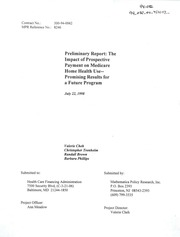
The impact of prospective payment on Medicare home health use : promising results for a future program : preliminary report PDF
Preview The impact of prospective payment on Medicare home health use : promising results for a future program : preliminary report
ContractNo.: 500-94-0062 MPRReferenceNo.: 8246 PreliminaryReport:The ImpactofProspective PaymentonMedicare HomeHealthUse- PromisingResultsfor aFutureProgram July22,1998 ValerieCheh ChristopherTrenholm RandallBrown BarbaraPhillips Submittedto: Submittedby: HealthCareFinancingAdministration MathematicaPolicyResearch,Inc. 7500SecurityBlvd,(C-3-21-06) P.O.Box2393 Baltimore,MD 21244-1850 Princeton,NJ 08543-2393 (609)799-3535 ProjectOfficer: AnnMeadow ProjectDirector: ValerieCheh CONTENTS Chapter Pag^ EXECUTIVESUMMARY ix I THEPER-EPISODEHOMEHEALTHDEMONSTRATION ANDEVALUATION 1 A. THEMEDICAREHOMEHEALTHBENEFIT 2 B. THEPER-EPISODEDEMONSTRATION 4 1. DemonstrationPaymentandIncentives 6 2. OtherDemonstrationProcedures 11 C. COMPONENTSOFANDAPPROACHTOTHEEVALUATION 13 1. AnalysisofAgencyDecisionsandOperations 14 2. AnalysisofProgramImpacts 16 D. GUIDETOTHERESTOFTHISREPORT 19 II DATAANDMETHODOLOGY 21 A. DATA 21 1. IdentifyingEpisodes 22 2. MedicareClaimsforOutcomesVariables 23 3. ControlVariables 23 4. AnalysisSample 29 5. SummaryStatisticsforControlVariables 30 B. METHODS 35 1. StatisticalModelsforEstimatingOverallImpacts 36 2. EstimatingSubgroupImpacts 38 3. HypothesisTestsfortheImpactEstimates 40 4. Weighting 41 5. DesignEffects 42 6. RobustnessChecks 43 iii CONTENTS(continued) Chapter Page III IMPACTSONTHEUSEOFSERVICESINTHE FIRST120DAYS 47 A. EXPECTEDEFFECTSOFPROSPECTIVEPAYMENT 47 B. DIDPROSPECTIVEPAYMENTAFFECTTHENUMBER OFVISITSRENDERED? 48 C. DIDPROSPECTIVEPAYMENTAFFECTTHEEPISODE COMPOSITION? 53 D. DIDPROSPECTIVEPAYMENTAFFECTTHEEPISODE LENGTH? 56 E. DIDPROSPECTIVEPAYMENTAFFECTAGENCY SUBGROUPSDIFFERENTLY? 60 F. ROBUSTNESSOFESTIMATEDIMPACTS 69 1. ComparisonofRegression-AdjustedandUnadjusted DemonstrationImpacts 69 2. WeightingAgenciesbyShareofEpisodes 72 3. EffectsofOutliers 74 4. EffectsofCensoring 75 5. InfluenceofUnobservedVariables 75 6. SummaryofRobustnessChecks > 78 IV SUMMARYANDCONCLUSIONS 79 A. KEYFINDINGS ....79 B. POLICYIMPLICATIONS 80 C. LIMITATIONSOFTHEANALYSIS 82 D. CONCLUSION 84 REFERENCES 85 APPENDIXA: DATAQUALITY 87 APPENDIXB COEFFICIENTESTIMATESFROMTHE : REGRESSIONONTOTALVISITSPEREPISODE 95 APPENDIXC CASEMIXADJUSTMENTSDURING : THEDEMONSTRATION 101 iv TABLES Table Page II.1 OUTCOMEVARIABLESDESCRIBINGMEDICARESERVICE USEDURINGTHE120-DAYAT-RISKPERIOD 24 11.2 CONTROLVARIABLESFORMULTIVARIATEANALYSIS, BYSOURCE 25 11.3 WEIGHTEDMEANSFOREXPLANATORYVARIABLESBY TREATMENTSTATUS,ANDTESTSFORDIFFERENCESIN TREATMENTANDCONTROLGROUPMEANS 31 III.1 THEIMPACTOFPER-EPISODEPAYMENTONTHENUMBEROF VISITSINFIRST120DAYS 50 111.2 DECOMPOSITIONOFTHEIMPACTOFPER-EPISODEPAYMENT ONTHENUMBEROFVISITSINFIRST120DAYS 52 111.3 THEIMPACTOFPER-EPISODEPAYMENTONTHETYPES OFCARERENDEREDINFIRST120DAYS 54 111.4 THEIMPACTOFPER-EPISODEPAYMENTONEPISODELENGTH 58 111.5 IMPACTOFPER-EPISODEPAYMENTONTHEUSEOF SERVICES,BYWHETHERTHEAGENCYISFOR-PROFIT ORNONPROFIT 63 111.6 IMPACTOFPER-EPISODEPAYMENTONTHEUSEOF SERVICES,BYWHETHERTHEAGENCYHADAHIGH-USE ORLOW-USEPRIORPRACTICEPATTERN 64 111.7 IMPACTOFPER-EPISODEPAYMENTONTHEUSEOF SERVICES,BYWHETHERTHEAGENCYISSMALLOR LARGESIZE 65 111.8 IMPACTOFPER-EPISODEPAYMENTONTHEUSEOF SERVICES,BYWHETHERTHEAGENCYISHOSPITAL- BASEDORFREESTANDING 66 111.9 UNADJUSTEDESTIMATESOFTHEIMPACTOFPER-EPISODE PAYMENTONTHENUMBEROFVISITSINFIRST120DAYS 70 V TABLES(continued) Table Page III.1 ROBUSTNESSCHECKSFORTHEPRINCIPALFINDINGSONTHE IMPACTOFPER-EPISODERATESETTINGDURINGTHEFIRST 120DAYS 73 vi FIGURES Figure Page III.1 EPISODELENGTHBYTREATMENTSTATUS(AGENCIES WEIGHTEDEQUALLY) 59 III.2 DISTRIBUTIONOFTHEPERCENTAGECHANGEINTHENUMBER OFVISITSPEREPISODE 77 vii EXECUTIVESUMMARY Aspartofitsongoingefforttostudymethodsofprovidingmorecost-effectivecare,theHealth CareFinancingAdministration(HCFA)hasrecentlyimplementedthePer-EpisodeHomeHealth ProspectivePaymentDemonstration. Underthedemonstration,participatinghomehealthagencies arepaidafixed,lump-sumpaymentforthefirst 120daysofeachepisodeofcareprovidedto Medicare beneficiaries and a predetermined rate for each visit thereafter. This method of compensationdifferssubstantiallyfromthecurrentmethodofMedicarereimbursementforhome healthservices,underwhichagenciesarereimbursedforactualcostsincurred,uptoaspecificlimit. Byallowingagenciestoretainmostofanysurpluspaymentsovercost,prospectivepaymentgives agenciesafinancialincentivetoprovidehomehealthcareinamorecost-efficientmannerthan undertraditionalcost-basedreimbursement. Ninety-oneagenciesinfivestatesenteredthethree-yeardemonstrationatthestartoftheir1996 fiscalyear. Priortothestartofthedemonstration,theparticipatingagencieswererandomlyassigned toeitherthetreatmentgroup(whichispaidunderthedemonstration'sprospectivepaymentmethod) oracontrolgroup(whichcontinuestobepaidunderMedicare'snormalmethodofcost-based reimbursement). Thepaymentstreatmentgroupagenciesreceiveforthefirst120daysofapatient episodearebasedoneachagency'sowncostsinthefiscalyearimmediatelyprecedingitsentryinto thedemonstration,adjustedforchangesinitscasemix. Whileeachagencyis"atrisk"duringthe first 120daysafteradmissionforallhomehealthvisitsthepatientneeds,HCFAreimburses treatmentagenciesforupto99percentoffiscal-yearlossesuptotheSection223paymentlimits.' ProfitsinexcessofspecifiedlimitsmustbesharedwithHCFA. RESEARCHQUESTIONSANDMETHODOLOGY Inthisreport,weexaminetheavailabledatafrom(roughly)thefirstyearofthedemonstration totesthypothesesaboutthepossibleeffectsofprospectivepaymentonpatients'useofMedicare- coveredservices.Giventhelimiteddatacurrentlyavailable,thispreliminaryreportfocusesonlyon homehealthusetakingplaceduringthe"at-risk"period(first120days)ofahomehealthepisode. Asmoredatabecomeavailable,futurereportswillprovideamorecompleteinvestigationof demonstrationimpactsonhomehealthuseandotheroutcomes.Here,wetesthypothesesconcerning theimpactsofthedemonstrationon(1)thenumberofvisitsprovided,bothintotalandbytype;(2) theper-episodemixofservicesprovided;and(3)thelengthofan episodeofcare. Inaddition,we alsotestwhethertheseoutcomesdifferedbetweensubgroupsofagenciesdefinedbytheirfor-profit status,size,andotherkeycharacteristics. Theanalysisisbasedonapproximately51,000homehealthepisodestakingplacein85ofthe demonstrationagencies(6ofthe91 agencieswereexcludedbecausetheydroppedoutofthe 'TheSection223paymentlimitsarecost-per-visitpaymentlimitsthatapplytoallagenciesin theMedicareprogram. ix demonstrationorhadinadequatedata). Alladmissionsoccurringbetweenanagency'sstartdateand August 1996areincluded. Medicareclaimsfilesprovidedthedataontheoutcomevariables describingtheuseofservicesduringthefirst120daysofhomehealthepisodes. Datacollectedat admission for case-mix adjustment and from prior Medicare claims provided measures of preadmissioncharacteristicsofpatientsadmittedtoagenciesparticipatinginthedemonstration. Dataonagencycharacteristicswereobtainedfromtheagencycostreportsandthedemonstration implementationcontractor. Ordinaryleastsquaresmodelsandlogisticmodelswereusedtoestimateprogrameffects, controllingforpreexistingdifferencesbetweentreatmentandcontrolagenciesinpatientandagency characteristics. Thisapproachprovedcrucialtoobtainingvalidimpactestimatessince,despitethe randomizationofparticipatingagencies,therewereseveralsignificantdifferencesbetweentreatment andcontrolagenciesasidefromthemethodofpayment. Observationsareweightedsothateach agencyisrepresentedequallyintheanalysis. Standarderrorsofimpactestimateswerecalculated usingspecialsoftwaredesignedtoaccountfortheeffectsofsampleclusteringandweighting,soas toavoidoverstatingtheprecisionoftheestimates. Analysesoftherobustnessofourregression estimatesshowedthattheywerenotsensitivetotheweightingscheme,statisticalmethods,ormodel specificationsused. FINDINGS VisitsperEpisodeFell17Percent Wefindstrongevidencethatprospectivepaymentreducedthetotalnumberofvisitsper episode,withlargeandstatisticallysignificanteffectsonskillednursing,homehealthaide,and medicalsocialworkervisits.Inaddition,wefindrelativelylargebutstatistically insignificant declinesinthenumberofvisitsbyphysicalandoccupationaltherapists. Overall,weestimatethat prospectivepaymentledtreatmentagenciestoprovideanaverageof7.8fewervisitsthancontrol agenciesduringthefirst120daysofeachepisode,adeclineof17percentrelativetothemeanfor controlgroupagencies(seeFigure1). Thisincludesanestimatedper-episodereductionofabout4 skillednursingvisits(down18percent),2.7homehealthaidevisits(dovm18percent),0.6physical therapyvisits(down 10percent),and0.3medicalsocialworkervisits(down37percent). The effectsonskillednursingandaidevisitsdominatetheeffectsonoverallvisitsbecausetheyaccount for83percentofallvisitsduringthefirst120daysofanepisode. X FIGURE1 AVERAGENUMBEROFVISITSPEREPISODE BYTREATMENTANDCONTROLAGENCIES NumberofVisits 45 TotalVisits SkilledNursing HomeHealth Visits AideVisits Treatment Control Source:MedicareClaimsData. Note: Treatmentgroupmeanisadjustedtoaccountfor preexistingdifferencesbetweentreatmentandcontrol agencies. ThePercentReceivingOccupationalTherapyDeclined Theproportionofpatientsreceivingoccupationaltherapydeclinedbyaboutone-thirdfromthe controlgroupmeanof12.6percent,fallingby4.4percentagepoints. However,theproportion receivingotherserviceswasrelativelyunaffected. Thereductioninoccupationaltherapymaybe duetofewerpatientsreceivingassessmentvisitsfromoccupationaltherapists. Theprogrameffect onthereceiptofanyskillednursingvisits,adropof2.6percentagepoints,wasalsostatistically significant,butsmall. Thisreductionmaybeduetoagencieshavingsomecasesopenedbyphysical therapists,whentherapyistheprimaryservicethepatientneeds. Fortheotherservices-aidecare (receivedby46percentofpatients),physicaltherapy(42percent),speechtherapy(3percent),and medicalsocialworkervisits(29percent)"therewerenodiscernibleeffects. xi ProspectivePaymentHadNoMajorEffectontheMixofVisitsProvided Prospective paymentappeared to have no effectontheproportion ofvisitsperepisode accountedforbyanyparticularspeciaUy. Estimatedeffectsontheproportionsofepisodevisitsthat wereforskillednursing,therapies(physical,occupation,andspeechcombined),aidecare,and medicalsocialserviceswereeachsmallandstatisticallyinsignificant,suggestingthattheimpacts ofthedemonstrationfellroughlyproportionallyacrossthemajorvisittypes. EpisodesWereShortenedby14Percent Consistentwiththeimpactsonthenumberofvisitsprovided,prospectivepaymentreducedthe lengthofepisodeswithintheat-riskperiodbyabout10days,or14percentofthemeanforcontrol groupagencies(70days). Moreover,prospectivepaymentreducedtheprobabilitythatanepisode exceeds120daysbyabout30percent(10percentagepoints)relativetothecontrolgroupmeanof 35percent. Thiseffect,whichaccountsforthemajorityofthetotalreductioninaverageepisode length,suggeststhattheproportionoflonghomehealthepisodesmaybesignificantlyreduced. The findingalsosuggeststhat,whenserviceuseduringtheperiodafter120daysisexamined,thetotal reductioninvisitsduetoprospectivepaymentmaybesubstantiallylarger. However,itwillalsobe necessarytoassesswhethertreatmentgrouppatientshavemorereadmissions. ProgramImpactsVariedLittlewithAgencyCharacteristics Wetestedwhetherimpactsonthefollowingoutcomesvariedwithagencycharacteristics: (1) numberofvisitsperepisode,(2)theproportionofvisitsthatwereskilled nursingvisits,(3)the proportionofvisitsthatwereaidevisits,and(4)episodelength. Agencycharacteristicsusedto define subgroups included whether agencies were for-profit, their size, whether they were freestandingorhospital-based,andtheirpredemonstrationpracticepattern(thatis,whetherthe agency provided more or less than the average number ofvisits per episode during the predemonstrationyear,forthecasemixserved). Wefindonlyoneimportantdifferenceinimpactsacrosstheagencysubgroups. Theimpacton totalvisitswassignificantlygreaterforagencieswithhigh-usepriorpracticepatternsthanforthose withlow-usepatterns. High-useagenciescutvisitsperepisodebynearly11visits(about20percent ofthecontrolgroupmean),comparedtoadropofonlyabout5visits(14percent)foragencieswith low-usepracticepatterns. Agencysizeandauspices(freestandingorhospital-based)havenoapparentinfluenceonthe estimatedeffectsforanyoftheoutcomesexamined,buteffectsonthemixofvisitsmaydifferby agencies' for-profitstatus. For-profitagenciessignificantlyreducedtheproportionofskilled nursingvisitsperepisode,butnonprofitagenciesdidnot. Effectsonotheroutcomesweresimilar forfor-profitandnonprofitagencies. Giventhatfor-profitagenciestendedtohavehigher-use practicepatternsinthepredemonstrationperiod,programeffectsonvisitsperepisodemaybegreater onaverageforfor-profitagenciesthanfornonprofitones. xii
